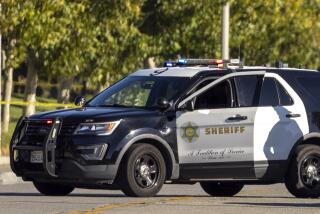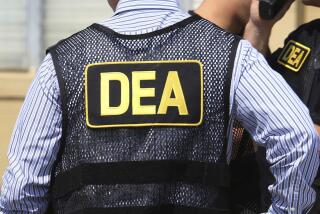Arrestee Is Among Few With Concealed Gun Permit : Weapons: It is not easy to have the sheriff’s office grant a request. But one man with a rap sheet slipped through.
- Share via
Paul Alfred Ragone is in select company.
Along with the likes of judges, lawyers, executives and celebrities, Ragone is allowed to pack a gun with the blessings of the Los Angeles County Sheriff’s Department.
Ragone--an appliance repairman, electronics parts clerk and sometimes photographer--was issued a permit to carry a concealed weapon despite a long record of arrests and his own sworn testimony that he suffers from mental disorders.
Gun control advocates point to the fact that Ragone can carry a loaded 9-millimeter handgun anywhere in the state as proof that granting such licenses is inherently dangerous.
“I think this is an example--without passing blame--as to why concealed weapon permits present a problem,” said Sandy Cooney, western region director of Handgun Control Inc.
In processing applications to carry a concealed weapon, the Sheriff’s Department checks with the state Department of Justice for criminal and mental commitment records. But deputies do no field investigations of applicants and, for the most part, simply process paper.
As for Ragone, most of his criminal record was somehow overlooked and deputies were unaware of his acknowledged mental problems, said Sheriff’s Sgt. Edward Barstow.
“I didn’t have his total rap sheet,” said Barstow, who reviews 75 to 100 concealed weapon applications per month before forwarding them to top department officials for final decisions.
*
But it is not easy to get a concealed weapon permit from the Sheriff’s Department. Such permits from a law enforcement agency are necessary to legally carry a gun in California. The permits are normally good for one year. An applicant to the Sheriff’s Department must present a convincing case that a clear and present danger is so great that carrying a gun is the only practical response. Simply living in a high-crime area, for example, is not considered sufficient cause.
The sheriff’s cautious policy has been recently adopted by the Los Angeles Police Department as a result of a tentative legal settlement in which the LAPD agreed to end its two-decade-old practice of rejecting all applications to carry concealed weapons.
“We don’t grant them lightly,” said Undersheriff Jerry Harper, who is among three top officials in the department who rule on permit applications.
“By the same token,” he added, “we don’t take the position that there should be zero gun permits issued. We believe that we have taken a responsible, cautious approach that is consistent with the law and in the best interests of the people.
“We don’t believe that it is in the best interests of the people to issue gun permits willy-nilly. We also don’t believe that in Los Angeles County with some 9 million people that there are not some people out there who have a legitimate need to have a gun permit.”
There were only 88 concealed weapon permits granted last year out of about 1,000 applications, bringing the total of such licenses, including renewals, to about 300 for this year.
Critics charge that the department favors influential people such as judges, attorneys, business executives and celebrities.
Sheriff’s officials deny the allegation, contending that high-profile people whose lives are threatened are especially vulnerable.
“If they are the chief executive officer of an oil company or something like that,” Barstow said, “they’re probably one of the biggest targets in the world.”
Simply being a high-profile personality is not enough to qualify for a permit, Barstow said.
“If a big celebrity came in and said: ‘I want a permit,’ it’s not just, ‘OK, we’ll give it to you.’ We ask, ‘What types of problems have you experienced?’ ”
Judges, Barstow said, are frequently granted concealed weapon permits because they often come face to face with violent criminals.
Barstow insisted, however, that “quite a few Joe Blow citizens” have also been issued permits.
*
But, besides Paul Ragone, there are apparently few “Joe Blows” on the sheriff’s list of 300 people who this year held concealed weapon permits. About two-thirds were judges, commissioners, hearing officers, attorneys, reserve peace officers or retired federal law enforcement officials. Another two dozen were businessmen, physicians or people connected with the entertainment industry.
Ragone was granted the one-year permit to carry a concealed weapon last June 30 after claiming that he had received death threats from holdup men, records show. The 43-year-old Norwalk resident would not talk to The Times on the advice of his attorneys.
He got the permit despite a criminal rap sheet that lists 10 arrests and three misdemeanor convictions--including a weapons violation--over a 20-year period from 1969-89. He was sentenced to jail once and put on probation three times. Sheriff’s officials have wide latitude in evaluating an application for a concealed weapon permit, but conviction on a felony or a serious misdemeanor is automatic grounds for denial.
Ragone was convicted in 1981 of a misdemeanor violation of carrying a loaded firearm in Bellflower. The arrest report indicates that he pointed a loaded gun at another driver during a high-speed chase. He was also arrested and released several times on suspicion of burglary from 1969-73 and convicted of petty theft in 1989.
Sheriff’s Sgt. Barstow recalled seeing records indicating that Ragone was convicted of petty theft and arrested--but not convicted--for drunk driving in 1970.
“But I missed the others,” he said. “I don’t know how, but I didn’t know about it. I don’t know if I misplaced it (Ragone’s rap sheet) or what.”
At the time Ragone got his permit to carry a gun, he testified in a lawsuit deposition that--as a result of being robbed--he was under the care of a psychiatrist and was using medication to cope with the shakes, depression and panic.
“Whenever I get the shakes real bad or real unstable, I take this (medication),” Ragone testified on May 19, 1993, a month before getting his concealed weapon permit.
“I didn’t want to wake up in the morning,” he testified in regard to his mental condition. “I went through periods I didn’t even want to live anymore.
“I can’t handle traffic,” he testified. “If I’m backed up in traffic and I get stopped, or stop-and-go, I feel trapped. I feel claustrophobic. I’ve got to do something.”
Because there are no field investigations of concealed weapon applicants, Barstow had no way of knowing about that testimony.
Barstow said the fee for a concealed weapon license, which is $45, would jump to about $2,000 if field investigations were conducted. “The expense that would be charged to the individual would be so steep that it would preclude a lot of people who are not wealthy from applying,” Barstow said.
Ragone’s application was approved, Barstow said, because of his claim that he was in danger from armed robbers who held him up June 14, 1992, and threatened to come back and kill him. Ragone claimed that he had received numerous threatening phone calls after the holdup, which occurred on the street. But Ragone testified in a civil suit deposition that the robbers did not take his wallet or credit cards, raising the question of how they would have known his identity or how to contact him.
“I don’t know,” Barstow said. “It was overlooked on my part.”
Court and sheriff’s records show that Ragone had numerous run-ins with the law.
He was first arrested in 1969 at age 19 on suspicion of burglary and was apparently released without prosecution. A year later, he was arrested on suspicion of drunk driving. The charge was dismissed and he was convicted of reckless driving and fined $120.
Less than three months later, Ragone, not yet 21, was arrested for possession of dangerous drugs and possession of alcohol by a minor. The drug charge was dropped and he was put on probation for one year for the alcohol violation.
A month later, Ragone was arrested for burglary, but the charge was dismissed. He was arrested in January, 1973, for trespassing. Again, the charge was dismissed.
Three months later, he was arrested for burglary. The rap sheet indicates that once more he was released: “Deemed not arrested, detained only, ascertained evidence insufficient.”
He was arrested again seven months later for possession of burglary tools, but again he apparently was not prosecuted.
Nearly eight years after that, on July 21, 1981, Ragone, by then 30, was arrested for carrying a loaded firearm, reckless driving and hit and run without personal injury.
The sheriff’s arrest report alleges that Ragone, driving at high speeds, chased a tow truck from Norwalk to Bellflower, sideswiped another car and pointed a loaded .357-caliber Ruger handgun at the tow truck driver. Ragone was convicted of possession of a loaded gun in a public place and put on two years probation.
Eight years later, on June 8, 1989, Ragone was taken into custody by a store detective in Norwalk and accused of shoplifting a $2.35-pocket level. He was convicted and sentenced to 60 days in jail, a $480 fine and two years probation.
On June 14, 1992, at 1:30 a.m., Ragone was shot in the buttocks by holdup men at a Bank of America automated teller in Norwalk.
Two months later, he filed suit against the Bank of America, the shopping center in which the ATM was located and the security firm that patrolled the center. The suit, which was dismissed in April and is on appeal, accuses the three companies of failing to provide proper security at the ATM site.
It was in connection with this suit that Ragone described the psychological problems he said were caused by the holdup.
A month after giving such testimony, Ragone received his permit to carry a loaded gun. A month and a half after that, he testified: “My nerves are starting to fall apart on me.”
Ragone’s permit to carry a concealed weapon expires at the end of this month.
And if he applies for a renewal?
“We’ll have to sit and take a look at some things,” Sgt. Barstow said.
More to Read
Sign up for Essential California
The most important California stories and recommendations in your inbox every morning.
You may occasionally receive promotional content from the Los Angeles Times.










